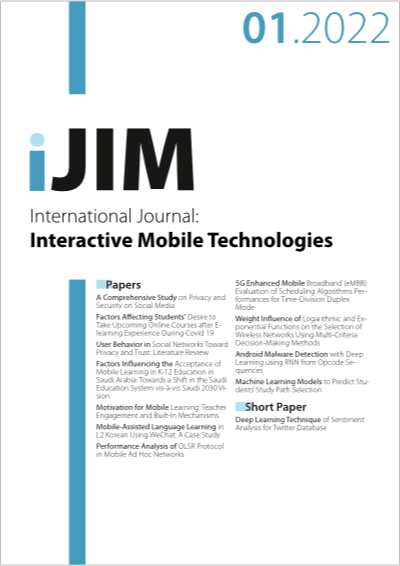Machine Learning Models to Predict Students’ Study Path Selection
DOI:
https://doi.org/10.3991/ijim.v16i01.20121Keywords:
educational data mining, decision trees, random forest, and logistic regressionsAbstract
Selecting a proper study path in higher education is a difficult task for many students. They either have a lack of knowledge on the study path offered or are unsure of their interest in the various options. The current educational setups enable us to collect valid and reliable data on student success and learning behaviour. This study explores and solves the problem of what path to select by proposing possible study paths with the help of machine learning algorithms. Learning analytics (LA) and educational data mining (EDM) are technologies that aid in the analysis of educational data. In this quantitative study, we applied a questionnaire to collect data from students at the Business Information Technology Department (Bite) at the Haaga-Helia University of Applied Science. We managed to collect 101 samples from students during 2017–2018. We used various machine learning algorithms and prediction models to assess the best approach for study path selection. We applied three performance scores of accuracy, Cohen’s Kappa, and ROC curve to measure the accuracy of the algorithm results. KNIME analytics was selected as a proper tool to pre-process, prepare, analyse, and model the data. The results indicate that Random Forest (94% accuracy) and Decision Tree (93% accuracy) are the best classification models for students’ study path selection. The contribution of this study is for educational data mining research to assess the comparison of various algorithms. Furthermore, this is a novel approach to predict students’ study path selection, which educational institutes should develop to assist students in their study path selection.
Downloads
Published
2022-01-18
How to Cite
Dirin, A., & Saballe, C. A. (2022). Machine Learning Models to Predict Students’ Study Path Selection. International Journal of Interactive Mobile Technologies (iJIM), 16(01), pp. 158–183. https://doi.org/10.3991/ijim.v16i01.20121
Issue
Section
Papers
License
Copyright (c) 2021 Amir Dirin, Charlese Adriana Saballe

This work is licensed under a Creative Commons Attribution 4.0 International License.



